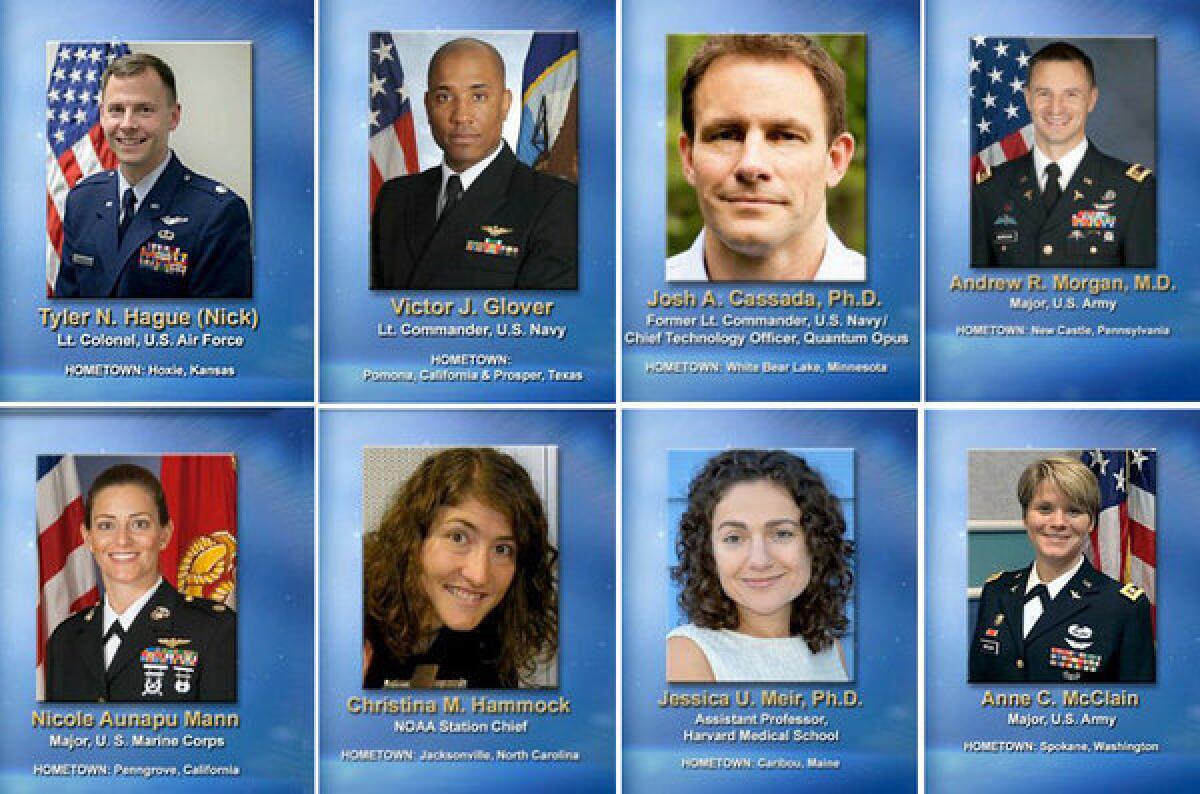NASA’s new astronauts: Will these men and women fly to Mars?

- Share via
It’s been two years since NASA’s space shuttle program came to an end, but thousands of Americans still dream of becoming astronauts. Eight of them – four men and four women – were introduced Monday as NASA’s astronaut candidate class for 2013.
More than 6,300 people applied to become astronauts-in-training, NASA Administrator Charles Bolden said in a video announcement. That is the second-most applications the space agency has ever received, according to a NASA statement.
The bios of the eight people selected will probably make you feel like a bit of a slacker. Two of them have PhDs and one is a physician training in sports medicine. Four have experience as test pilots for the Navy or Air Force. One person is working at the Pentagon on ways to defeat the homemade bombs that have plagued troops in Iraq and Afghanistan. One of them is the station chief for the National Oceanic and Atmospheric Administration’s research outpost in American Samoa.
Many headlines are emphasizing the fact that half the astronaut candidates are women – the first time NASA has had gender parity in an astronaut class. (There were four women in the astronaut candidate class of 1998, but they accounted for just 16% of the class’s 25 members, according to a post from Phys.org).
PHOTOS: Amazing images from space
Some NASA watchers certainly see this as a cause for celebration. On the other hand, the fact that we’re even talking about whether these new astronauts are men or women is a sign that there’s still a ways to go. In the earliest days of the American space program, 13 women were being considered for the astronaut corps before then-Vice President Lyndon B. Johnson quashed a proposal to test their worthiness for space, Meg Waite Clayton wrote in a Los Angeles Times op-ed marking the 50th anniversary of the first spaceflight by a woman.
In his video message, Bolden said the new astronaut trainees are “ready to help lead the first human mission to an asteroid and then on to Mars.” All eight of them are between the ages of 34 and 39, so they’d be in their 50s (at least) by the 2030s, the soonest NASA would actually dispatch humans to the Red Planet. NASA has an ambitious plan to capture an asteroid and drag it into orbit around the moon in the 2020s, which could be a more feasible option for working in space.
Until then, the astronauts could help test space vehicles built by private companies and spend time aboard the International Space Station, Bolden said -- though recently retired Canadian astronaut Chris Hadfield would be a tough act to follow.
Mars settlers wanted. Send audition tape. No, seriously.
The eight astronaut candidates unveiled Monday were selected after a 1 1/2-year job application process. In alphabetical order, they are:
* Josh A. Cassada, who earned a PhD in physics and co-founded a start-up company called Quantum Opus to make devices to high-quality photon detectors. He is 39 and hails from White Bear Lake, Minn.
* Victor J. Glover, a lieutenant commander in the Navy who is serving as a Navy Legislative Fellow in Congress. The 37-year-old is from Pomona and graduated from Cal Poly San Luis Obispo.
* Tyler N. Hague, a lieutenant colonel in the Air Force who is working at the Defense Department as deputy chief of the Joint Improvised Explosive Device Defeat Organization. He is 37 and his hometown is Hoxie, Kan.
* Christina M. Hammock, the station chief for the NOAA’s research center on Tutuila island in American Samoa, halfway between Hawaii and New Zealand. The 34-year-old is from Jacksonville, N.C.
* Nicole Aunapu Mann, a major in the Marine Corps who is now an integrated product team lead at the U.S. Naval Air Station, Patuxent River in Maryland. She is 35 and a graduate of the U.S. Naval Academy and Stanford University.
* Anne C. McClain, a major in the Army who flies OH-58 helicopters and recently graduated from the U.S. Naval Test Pilot School at Naval Air Station, Patuxent River. The 34-year-old is from Spokane, Wash.
* Jessica U. Meir, who earned her PhD from the Scripps Institution of Oceanography at UCSD for studies of how animals like penguins and elephant seals are able to dive underwater for long periods without running out of oxygen. As an assistant professor of anesthesia at Harvard Medical School, she is studying how bar-headed geese are able to fly in low-oxygen conditions when they migrate over the Himalayas. This won’t be Meir’s first stint with NASA: The 35-year-old was an aquanaut in the NASA Extreme Environment Mission Operations program, known as NEEMO. She also flew on NASA’s parabolic flight aircraft as part of her study of how microgravity affects the human body.
* Dr. Andrew R. Morgan, a major in the Army who has served as flight surgeon for the Army special operations community. The 37-year-old from New Castle, Pa., has worked in emergency medicine and is wrapping up a fellowship in sports medicine.
NASA says the eight will “receive a wide array of technical training at space centers around the globe to prepare for missions to low-Earth orbit, an asteroid and Mars.” The civilians among them can expect to earn between $64,724 and $141,715 per year, depending on their education and experience. Those in the Army, Navy, Air Force or Marines will continue to earn their military salaries.
Feeling inspired? You can apply to NASA’s Astronaut Selection Program online here. Flying experience is not necessary.
Return to Science Now.







